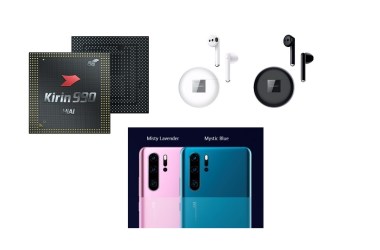Huawei used IFA 2019 to unveil a cohesive flagship lineup centered on the Kirin 990 series, with a dedicated 5G version, together with the upgraded HUAWEI FreeBuds 3 that run on Huawei’s own Kirin A1 chip, and a refreshed HUAWEI P30 Pro sporting new color options and a refined design. The company also confirmed that the upcoming Huawei Mate 30 series will be powered by the Kirin 990 family, underscoring Huawei’s strategic emphasis on advanced 5G experiences, enhanced AI capabilities, and a tightened ecosystem of devices. In parallel, Huawei introduced two notable audio and design products—the FreeBuds 3 wireless earbuds and the P30 Pro’s aesthetic refresh—while outlining the broader 5G-ready roadmap for flagship devices and the Mate series. Singapore was singled out as a key market to receive the new products in October 2019, signaling a focused early rollout in select markets before a wider global launch. This summary sets the stage for a detailed look at the technologies, product strategy, and market implications discussed during the event and subsequent press materials.
Kirin 990 Series and the 5G-Ready Flagship SoC Strategy
The centerpiece of Huawei’s IFA 2019 presentation was the Kirin 990 family, which includes both a standard Kirin 990 and a 5G-enabled Kirin 990 (5G). This dual-variant approach positions Huawei to offer a flagship-grade system-on-a-chip (SoC) that can address both current 4G networks and the then-emerging 5G ecosystem. The Kirin 990 (5G) is presented as the world’s first flagship 5G SoC, designed to deliver a superior 5G connectivity experience in the early phase of 5G commercialization. Huawei highlighted that the 5G variant has undergone comprehensive upgrades across performance, power efficiency, AI computing, and image signal processing (ISP) to meet elevated user expectations for speed, smoothness, and intelligent features in daily mobile use.
The Kirin 990 family leverages a cutting-edge 7 nm plus EUV manufacturing process, resulting in a compact silicon footprint that enables a highly integrated solution. The 5G version integrates a 5G modem directly into the same die, achieving a smaller footprint and lower power consumption while maintaining high performance. This architectural choice also supports both non-standalone (NSA) and standalone (SA) 5G architectures, as well as both TDD and FDD full-frequency bands. In practice, this enables devices built on Kirin 990 (5G) to operate across diverse networks and configurations, providing flexibility for operators and end users as networks evolve.
Performance targets for the Kirin 990 (5G) emphasize a leading mobile experience. Huawei’s data points include a peak downlink rate of 2.3 gigabits per second and an uplink peak rate of 1.25 gigabits per second. While real-world results vary by scenario, these figures illustrate the intended capability of delivering ultra-fast 5G experiences, especially in dense urban environments and areas with solid network deployment. The combination of high-speed 5G, advanced AI, and efficient power management aims to deliver a holistic improvement to the overall mobile experience, including web browsing, streaming, gaming, and professional workloads.
A core element of the Kirin 990 (5G) is its dual-core NPU, built on Huawei’s Da Vinci architecture. This dual-core design is intended to deliver robust AI computing power while maintaining efficient power usage, a balance that becomes critical as 5G devices demand more intelligent processing for tasks such as real-time scene analysis, computer vision, and on-device AI work. The large NPU cores are built to handle heavy AI workloads, while the tiny core architecture provides ultra-low power operation for energy-conscious tasks and background processing. This combination seeks to ensure that AI-driven features remain responsive without imposing excessive battery drain, enabling smarter photography, faster on-device translation, and more contextual assistant capabilities.
In addition to AI improvements, the Kirin 990 (5G) brings notable CPU and GPU enhancements. The SoC features a three-level CPU power efficiency structure, comprised of two ultra-large cores, two large cores, and four small cores, with a maximum clock rate reaching up to 2.86 GHz. This scalable architecture supports efficient performance across a broad spectrum of workloads—from lightweight app usage to demanding computational tasks and gaming. For graphics, the Kirin 990 employs a 16-core Mali-G76 GPU, complemented by a system-level Smart Cache that optimizes data flow and reduces bandwidth pressure, contributing to improved energy efficiency and sustained performance in gaming and graphics-intensive applications.
Huawei also introduced an upgraded gaming framework, known as Kirin Gaming+ 2.0, which is designed to optimize the interaction between hardware and software for a smoother gaming experience. This includes closer collaboration between the CPU, GPU, memory system, and network capabilities to deliver lower latency, reduced tearing, and more consistent frame rates, particularly in online multiplayer scenarios where network performance and on-device processing must align.
A critical area of improvement in the Kirin 990 (5G) is the imaging processing pipeline. The new ISP 5.0 introduces professional-level noise reduction through block-matching and 3D filtering (BM3D) to capture brighter and sharper images in challenging low-light environments. It also debuts dual-domain video noise reduction for more accurate noise processing in video capture, enabling higher-quality clips in real-world settings. The combination of BM3D and dual-domain NR supports more faithful color, detail preservation, and enhanced video fidelity, contributing to a more compelling mobile photography and videography experience.
Beyond raw performance and imaging, Huawei emphasized the Kirin 990 (5G)’s ability to support a broader 4G user base through extended energy efficiency and AI-powered enhancements. The goal, according to the company, is to deliver a noticeably elevated mobile experience not only for early adopters of 5G but for a larger portion of users who remain on 4G networks or operate across mixed network scenarios. By focusing on efficiency, AI inference, and advanced ISP capabilities, Huawei aims to ensure that the Kirin 990 (5G) remains a compelling upgrade path for flagship smartphones and the Mate series during the transition phase to full 5G adoption.
In terms of ecosystem, Huawei highlighted that the Kirin 990 (5G) building blocks are designed to work in concert with other flagship innovations in the Mate series and partner devices, reinforcing a holistic experience across devices. This includes improved device-to-device communication, cross-platform AI capabilities, and the prospect of more sophisticated photography, video, and editing workflows that take advantage of on-device AI processing. The architecture is also intended to be adaptable to future software and hardware refinements, ensuring that early 5G devices remain competitive as networks mature and new features become available.
The announcement also positioned the Kirin 990 as a technology platform that would extend beyond a single device family, enabling Huawei’s broader ambitions in smart devices and the connected ecosystem. By delivering a powerful combination of 5G connectivity, AI acceleration, enhanced imaging, and energy efficiency, Huawei aimed to set a new standard for flagship mobile platforms and establish a foundation for the Mate series and related devices to deliver premium experiences in the years to come.
Optimizing 5G Readiness: NSA/SA, Full-Frequency Support, and Real-World Impacts
Huawei’s technical briefings at IFA 2019 underscored the 5G readiness of the Kirin 990 (5G) with a focus on compatibility and real-world deployment. The inclusion of full-frequency band support across TDD and FDD modes ensures that devices built on this platform can connect to a diverse range of networks as 5G adoption spreads globally. This capability is particularly important for initial 5G deployments, where operators may choose specific spectrum allocations and network architectures. By enabling both NSA and SA configurations, Huawei aimed to provide a seamless transition path for devices to operate efficiently regardless of network topology, while still enabling the highest possible data rates in supported environments.
The integration of a 5G modem within the Kirin 990 (5G) also emphasizes a compact silicon design that reduces the physical footprint of the device’s radio stack. This compactness benefits handset design by allowing more space for other components such as batteries, sensors, and imaging modules, while also reducing thermal and power considerations common in tightly integrated systems. The end-user implications are clear: faster download speeds, lower latency, and a more responsive experience for streaming, gaming, and cloud-based AI tasks, all while maintaining a battery life profile that keeps devices usable throughout a typical day.
From a broader perspective, the Kirin 990 (5G) represents Huawei’s effort to accelerate a self-contained 5G ecosystem within its mobile devices. By coupling high-speed connectivity with AI processing and imaging enhancements on a single chip, Huawei sought to deliver a “one-stop” solution for flagship devices that could handle a wide array of tasks—from professional photography and video editing to on-device translation and smart assistant functions. This approach aligns with a broader market strategy that emphasizes on-device intelligence and network-aware performance as core differentiators for premium smartphones in the 5G era.
In practical terms, the Kirin 990 (5G) aims to deliver a balanced blend of performance and efficiency. The three-level CPU architecture facilitates dynamic performance scaling to match workload demands, while the Mali-G76 GPU supports modern graphics-intensive apps and games with improved efficiency. The Smart Cache feature contributes to efficient data reuse, reducing memory bandwidth requirements and helping to control power draw during demanding tasks. Collectively, these design choices reflect Huawei’s intent to deliver a flagship platform that remains capable across a broad spectrum of use cases, from daily productivity to immersive media experiences and high-end gaming.
Of course, the practical impact for consumers depends on several factors, including software optimization, app behavior, and carrier network performance. Huawei’s messaging positions the Kirin 990 (5G) as a platform that will enable the Mate 30 series and related devices to deliver faster, more capable experiences in the 5G era, while still offering robust performance for 4G users. The balance of AI, imaging, and connectivity is presented as a holistic upgrade, not merely a hardware spec sheet, with the expectation that software features and on-device intelligence will grow in tandem with network capabilities.
Imaging, ISP 5.0, and the Leap in Mobile Photography and Video
A key differentiator highlighted during the Kirin 990 (5G) introduction was the imaging pipeline, driven by the new ISP 5.0. Huawei described this as a landmark upgrade that pioneers professional-level noise reduction via BM3D block-matching and 3D filtering, enabling brighter and sharper images in low-light conditions. The combination of BM3D with 3D filtering is designed to preserve edge detail and texture, delivering cleaner images even when light is scarce. The ISP 5.0 is also the first to introduce dual-domain video noise reduction, which enhances video quality by addressing noise in both the spatial and temporal domains, yielding more faithful and cinematic results.
In addition to still photography, the Kirin 990 (5G) introduces real-time video post-processing and rendering powered by AI segmentation. This feature allows color grading and frame-by-frame adjustments to be guided by intelligent segmentation, enabling more precise adjustments to skin tones, lighting, and scene composition. The overall goal is to enable Huawei devices to capture not only technically strong stills but also high-quality, production-like video content with minimal post-processing required by the user.
Huawei’s emphasis on ISP 5.0 also includes improvements in color depth, dynamic range, and detail preservation across a variety of shooting conditions. The ISP upgrades are designed to work in concert with the AI capabilities of the Da Vinci-powered NPU, enabling on-device intelligence to optimize capture parameters in real time. For users who rely on photography and videography as a core capability—whether for social media, professional content creation, or personal documentation—these improvements translate into tangible benefits in image fidelity, color accuracy, and general image quality.
The combination of advanced ISP capabilities and AI-powered processing also has implications for computational photography workflows. On-device AI can assist in scene recognition, exposure optimization, and subject tracking, delivering smarter shooting experiences across modes such as night mode, portrait, and zoom. In practical terms, that means better performance in real-world scenarios, fewer post-processing hassles, and a workflow that allows creators to capture compelling content with confidence.
The imaging stack is complemented by a robust ISP suite that allows the camera subsystem to support a broader set of features in a more efficient manner. In practice, this translates into faster autofocus, improved exposure handling, and better video stabilization, even in challenging ambient conditions. The result is a more compelling overall camera experience that aligns with Huawei’s broader emphasis on imaging as a core differentiator in flagship devices.
HUAWEI P30 Pro: Refined Design, New Colors, and Enhanced Visual Capabilities
In parallel with the Kirin 990 (5G) unveil, Huawei introduced a refreshed HUAWEI P30 Pro. The device retains its status as one of Huawei’s flagship smartphones while receiving a refined design language and two new color options: Mystic Blue and Misty Lavender. The Mystic Blue evokes the reflection of the sky on a calm sea, while Misty Lavender captures the softness of a sunset over a tranquil beach, offering a more premium, matte-surface finish achieved through a careful sanding process. The new aesthetic direction complements the P30 Pro’s imaging prowess, while maintaining the design philosophy of elegance, precision, and modernity that has defined the P-series.
Beyond aesthetics, the P30 Pro continues to emphasize Huawei’s strengths in photography and video capture, supported by the broader imaging ecosystem introduced with the Kirin 990 family. The device integrates with the on-device AI capabilities and ISP advancements to provide a high-quality multimedia experience, including improved low-light performance, color accuracy, and detail preservation. The combination of improved hardware and software tools helps to deliver a suite of photography and video editing features that bring professional-style capabilities to more users, enabling richer content creation and creative expression.
The P30 Pro’s new features extend into the software layer as well, with the anticipated release of EMUI 10. The update promises a smoother and smarter user experience, with refined navigation, adaptive interactions, and enhanced performance optimization. EMUI 10 is positioned as part of Huawei’s broader strategy to deliver a refined, AI-assisted interface that complements the device’s upgraded imaging pipeline and processing capabilities. The integration of EMUI 10 with the Kirin 990 series is designed to yield a cohesive user experience that leverages hardware and software synergies, resulting in faster app launch times, better multitasking, and more responsive interactions.
From a consumer perspective, the color refresh and the updated software environment aim to broaden the P30 Pro’s appeal, particularly among users who value both aesthetics and top-tier imaging performance. The matte finish and color options align with fashion-conscious audiences seeking devices that reflect personal style while delivering flagship-level camera performance. The combination of advanced hardware and refined software underlines Huawei’s commitment to maintaining the P-series as a leading blend of design, camera technology, and user experience in the premium smartphone segment.
In terms of availability, Huawei signaled that the new HUAWEI P30 Pro would be available in Singapore in October, with the precise launch date and pricing to be announced subsequently. This timing aligns with Huawei’s broader IFA strategy of delivering flagship devices across key markets in the fall period, creating anticipation ahead of the broader global rollout. The P30 Pro’s refreshed design and advanced imaging capabilities are positioned as a strong draw for early adopters and photography enthusiasts who value both style and substance in a premium mobile device.
HUAWEI FreeBuds 3: A New Benchmark in Wireless Audio with Kirin A1
Another highlight at IFA 2019 was Huawei’s introduction of the HUAWEI FreeBuds 3, the company’s latest flagship wireless earphones. The FreeBuds 3 feature an elegant, compact design with a round charging case that offers a comfortable grip and a secure fit. The earphones come in two color options: black and white, and they are designed to prioritize wearer comfort and stability during extended use. The standout hardware advancement is the use of Huawei’s own Kirin A1 chip, a dedicated audio processing unit that enables stable and fast connectivity, high-quality sound, and intelligent features that optimize the listening experience.
As the world’s first wireless earphones to run on Huawei’s self-developed Kirin A1 chip, the FreeBuds 3 claim to deliver a highly stable wireless connection and responsive performance across use cases, including voice calls, music streaming, and media playback. The A1 chip is designed to optimize power efficiency, reduce latency, and contribute to improved audio processing, including noise management and sound quality enhancements. The FreeBuds 3 also emphasize smart noise cancellation capabilities, aiming to provide an effective listening experience across a range of environments—from noisy commutes to quiet home settings.
In terms of user experience, Huawei positioned the FreeBuds 3 as offering a superior combination of comfort, connectivity, and audio quality. The true wireless design supports easy pairing and mobility, while the Kirin A1 chip is intended to ensure reliable performance even in scenarios where Bluetooth bandwidth is stressed by multiple devices or higher-quality codecs. The emphasis on open wireless use and smart noise cancellation differentiates the FreeBuds 3 from competing products by highlighting both on-device processing and software-driven noise management that adapts to surrounding noise levels.
From a market perspective, the FreeBuds 3’s October availability in Singapore aligns with Huawei’s strategy to test and establish a foothold in key markets as part of a broader 5G-enabled ecosystem. The launch complements the P30 Pro refresh and the Kirin 990 (5G) introduction, creating a complete package of flagship devices that illustrate Huawei’s push into premium audio, imaging, and mobile computing experiences. The FreeBuds 3 are positioned to appeal to users who value premium sound, sophisticated design, and the convenience of wireless, on-device processing for noise management and connectivity optimization.
The FreeBuds 3’s features—coupled with the Kirin A1’s neural processing capabilities—also have implications for future software features and services, including adaptive noise cancellation, improved call quality, and potential integrations with Huawei’s AI ecosystem. By emphasizing these capabilities at IFA 2019, Huawei signaled its intention to extend the utility of its chip technology beyond smartphones to a broader range of wearables and audio devices, reinforcing the company’s strategy to build an interconnected ecosystem that harnesses on-device AI and high-efficiency processing.
HUAWEI Mate 30 Series and the Roadmap for 5G Flagship Devices
The IFA 2019 presentation also set the stage for Huawei’s Mate series, confirming that the next Mate generation would be powered by the Kirin 990 family, including the 5G-enabled variant. This positioning indicates Huawei’s ambition to extend the Kirin 990’s capabilities into its flagship lineup beyond the P-series, signaling a more expansive strategy to deliver premium 5G experiences across multiple device families. The Mate series is expected to leverage the same architectural advantages—advanced AI, enhanced ISP capabilities, and improved energy efficiency—while adding the design language and hardware configurations characteristic of Mate devices.
Huawei’s messaging around the Mate 30 series emphasizes the ongoing evolution of 5G and AI features, aiming to deliver a complete ecosystem where communications, photography, gaming, and smart features are tightly integrated. The press materials suggested a broad spectrum of improvements—higher processing headroom, better camera performance in diverse environments, and smoother daily use with intelligent optimization—intended to preserve Huawei’s competitive edge in the premium segment as 5G networks mature, and as app developers and consumers alike begin to demand more sophisticated on-device intelligence.
From a consumer expectations standpoint, the Mate 30 series’ kinship with the Kirin 990 family implies a consistent experience: fast 5G connectivity, robust AI processing, and high-quality imaging enhancements. The SoC’s capabilities in AI inference and image processing could translate into improvements in real-time scene analysis, adaptive scene detection, and smarter post-capture editing. The device’s energy efficiency advances, driven by CPU architecture and GPU optimizations, would be critical in maintaining battery life in larger-screen flagship devices that typically demand more power.
The broader strategy for the Mate series aligns with Huawei’s aim to deliver premium devices with a focus on 5G readiness, AI-powered software experiences, and top-tier photography and video performance. By leveraging the Kirin 990 family across multiple device lines, Huawei seeks to ensure consistency of experience, reduce fragmentation, and enable seamless cross-device features that rely on shared AI capabilities and imaging pipelines. For developers and partners, this creates a more coherent platform with a unified set of on-device processing capabilities that can be leveraged for innovative apps and services.
Singapore Launch Window: Availability, Pricing Uncertainties, and Market Strategy
Huawei announced that the newly refreshed HUAWEI P30 Pro and the HUAWEI FreeBuds 3 would be available in Singapore in October 2019, with final dates and pricing to be announced at a later time. The timing suggests a carefully planned regional rollout that leverages Singapore as a launchpad for Southeast Asia and as a proving ground for the new Kirin 990-based devices before broader global availability. Market strategy discussions around this window emphasize the importance of establishing a strong foothold in markets with sophisticated consumer electronics ecosystems, robust network infrastructure, and a high demand for premium devices.
Pricing details, often a sensitive aspect of flagship launches, were reserved for later announcements. The Singapore release plan reflects Huawei’s approach of generating early interest and retail momentum, while also allowing the company to fine-tune logistics, availability, and marketing messages ahead of wider global introductions. In addition to retail channels, Huawei’s strategy would typically include carrier partnerships, online marketplaces, and in-store demonstrations designed to highlight the capabilities of the Kirin 990-based devices, including 5G connectivity, AI-driven photography, and the new EMUI 10 software experience.
From a regional perspective, Singapore’s market characteristics—high smartphone penetration, a discerning consumer base, and well-developed telecommunications networks—provide a favorable environment for showcasing the capabilities of the Kirin 990 family and the new audio devices. The enhanced imaging pipelines and on-device AI may appeal to photography enthusiasts and content creators who value high-quality media capture, while the FreeBuds 3 offer a complementary audio experience for daily commuting and multimedia consumption. The October launch aligns with broader fall product cycles, enabling Huawei to maintain momentum as other manufacturers introduce new flagship devices in the latter part of the year.
The Singapore availability also marks an early test of Huawei’s supply chain readiness and retail execution for the Kirin 990-based devices in a high-demand market. By monitoring customer feedback, retail performance, and post-launch support requirements in Singapore, Huawei can glean insights to inform its global release strategy and refine marketing messaging for subsequent markets. The cross-market synchronization of launch timelines underscores Huawei’s intent to deliver a consistent flagship experience across regions while adapting to local distribution channels and consumer preferences.
Leadership Commentary and the “Rethink Evolution” Message
During the Berlin keynote, Huawei Consumer Business Group CEO Richard Yu presented the company’s vision for the future under the banner of “Rethink Evolution.” Yu framed the Kirin 990 series, including the 5G variant, as a catalyst for a broader transformation in how users experience mobile technology. He highlighted the breakthroughs in 5G connectivity, AI computing, ISP advances, and energy efficiency as key enablers for more capable devices that can intelligently anticipate user needs and adapt to a rapidly changing network landscape.
Yu’s remarks emphasized Huawei’s commitment to delivering continuous improvements in flagship devices, with the Kirin 990 (5G) representing a strategic milestone in the company’s 5G roadmap. The message conveyed a sense of forward momentum—an attempt to position Huawei as a leader in the early 5G era by delivering technology that enhances everyday use and unlocks new possibilities for photography, video, gaming, and smart device integration. The keynote’s emphasis on evolution reflects Huawei’s broader strategic objective of offering users a more intelligent, more connected mobile experience in which hardware and software work together to deliver tangible benefits in real-world scenarios.
The leadership narrative at IFA 2019 also underscored Huawei’s intent to broaden the appeal of its flagship devices by combining cutting-edge silicon with consumer-focused features. The Kirin 990 family is presented not only as a performance upgrade but as an enabler of smarter software experiences, better imaging quality, and more efficient energy management. This holistic approach is designed to resonate with a wide range of users—from photographers seeking improved low-light performance to gamers looking for smoother frame rates and faster AI-assisted tasks to general consumers who value a faster, more responsive mobile experience.
From a communications perspective, Huawei used the platform to emphasize its aspirations for a robust 5G ecosystem that extends beyond smartphones. The company’s messaging suggested a strategy that links high-speed connectivity with on-device AI and imaging technologies to deliver a seamless, integrated user experience. The “Rethink Evolution” theme signals a belief that 5G is not merely about faster networks but about reimagining what mobile devices can do when AI-powered features, sophisticated ISP capabilities, and intelligent software are part of the core system-on-a-chip design.
Huawei Consumer BG: Global Reach, R&D Footprint, and Strategic Outlook
Huawei’s press materials highlighted the breadth of Huawei Consumer BG’s global operations, noting a presence in more than 170 countries and the involvement of sixteen R&D centers across the United States, Germany, Sweden, Russia, India, and China. This global footprint underscores Huawei’s commitment to localization, rapid product iteration, and the ability to tailor devices to various markets while maintaining a consistent core platform. The scale of R&D investment is framed as a differentiator in terms of innovation, enabling the rapid development and deployment of new chip technologies, imaging capabilities, software optimization, and cross-device integration.
The Consumer BG division focuses on smartphones, PCs and tablets, wearables, and cloud services, among other areas. This broad portfolio supports Huawei’s objective of creating an integrated ecosystem in which devices work together to deliver a cohesive user experience. The claim of “one of Huawei’s three business units” reflects the company’s internal organization around consumer devices, cloud services, and related offerings, with a strategic emphasis on bringing the latest technological advances—such as the Kirin 990 series and EMUI 10—to a wide audience through multiple channels.
The company’s global reach also implies a substantial emphasis on international partnerships, supply chain resilience, and localized marketing strategies to meet diverse consumer preferences. The strategic outlook for Huawei Consumer BG is to continue expanding its presence in mature markets while maintaining momentum in emerging regions, leveraging flagship innovations (like the Kirin 990 series and FreeBuds 3) to reinforce brand strength and consumer loyalty. The combination of deep technical expertise, a broad product range, and a global market footprint positions Huawei to shape premium mobile experiences across different regulatory environments and consumer segments.
In terms of corporate messaging, Huawei’s communications around the Kirin 990 family, the P30 Pro refresh, the FreeBuds 3, and the Mate series collectively emphasize a seamless integration of hardware excellence, software intelligence, and an expanding ecosystem. The strategic narrative highlights 5G readiness, on-device AI, advanced imaging, and premium audio as core differentiators that can drive growth and user satisfaction in competitive markets worldwide. By articulating a coherent vision that ties together flagship devices, software updates, and ecosystem alignment, Huawei aims to position itself as a leading innovator within the rapidly evolving mobile technology landscape.
Conclusion
Huawei’s IFA 2019 offerings showcased a forward-looking strategy anchored in the Kirin 990 family, including a 5G variant, and reinforced by the FreeBuds 3 with the Kirin A1 chip, along with a refreshed P30 Pro and a future-confirmed Mate series powered by the same generation of silicon. The announcements underscored a comprehensive approach to 5G readiness, AI-powered imaging, and an integrated ecosystem designed to deliver high-performance experiences across devices. Availability details for Singapore in October 2019 highlighted a careful market rollout strategy aimed at establishing momentum in key markets as the 5G era began to unfold. Together, these products illustrate Huawei’s ambition to combine cutting-edge processing, intelligent software, and premium hardware into a cohesive flagship experience that appeals to enthusiasts and mainstream users alike as networks and consumer expectations continue to evolve.





